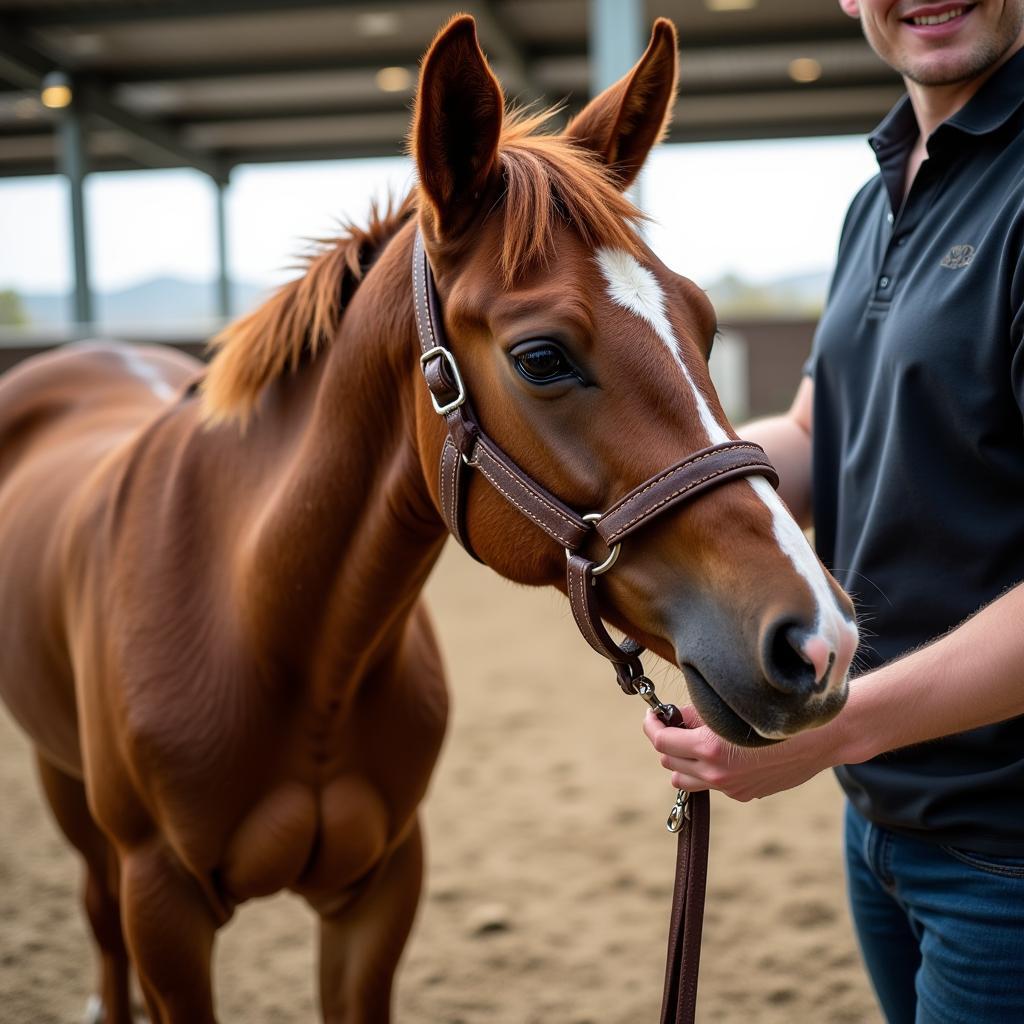Horse Breaking Equipment plays a crucial role in the training process of young horses. It’s essential to choose the right tools, not just for the horse’s comfort and safety, but also for the trainer’s effectiveness. This guide will explore the essential pieces of horse breaking equipment, explaining their function and importance in creating a positive and successful training experience.
Understanding the Importance of Proper Horse Breaking Equipment
Starting a young horse under saddle is a significant milestone, requiring patience, skill, and the right equipment. Choosing appropriate horse breaking equipment is crucial for establishing clear communication, building trust, and ensuring the well-being of both horse and handler. Using the correct tools can prevent injury and discomfort, allowing the horse to learn and progress confidently. Well-maintained and properly fitted equipment also contributes to the trainer’s safety, allowing them to focus on the training process. Investing in quality horse breaking equipment is an investment in the future success of your horse. Similar to selecting the right nylon halters for horses, understanding the function and fit of breaking equipment is paramount.
Key Pieces of Horse Breaking Equipment
Several essential pieces of equipment are commonly used during the horse breaking process. Each serves a specific purpose and contributes to a safe and effective training experience.
The Right Halter and Lead Rope for Breaking
The halter and lead rope are fundamental tools for groundwork and initial training under saddle. A well-fitting halter provides control and allows for clear communication through pressure and release. A sturdy lead rope, typically made of a durable material like nylon, offers secure handling. A good lead rope should be comfortable to hold and long enough to allow for safe maneuvering. Choosing the correct halter, much like choosing between dark horse vs dark horse premium products, depends on individual needs and preferences.
 Horse Breaking Halter and Lead Rope
Horse Breaking Halter and Lead Rope
Saddles Designed for Breaking
The saddle plays a crucial role in the horse’s comfort and the rider’s balance. A correctly fitted breaking saddle distributes the rider’s weight evenly, preventing pressure points and discomfort. It should allow for freedom of movement and provide a secure seat for the rider. Some breaking saddles are designed with deeper seats and higher cantles for added security during the early stages of training. Choosing a saddle is a personal process, similar to designing a horse barn style barndominium, as it requires careful consideration of both horse and rider needs.
Importance of Proper Bridles and Bits
The bridle and bit are essential for communication and control. The bridle should fit comfortably and securely, allowing for precise rein aids. The choice of bit is crucial and should be based on the horse’s individual needs and sensitivity. Starting with a milder bit and progressing gradually is generally recommended. It’s important to prioritize the horse’s comfort and avoid harsh bits that can cause pain and resistance.
Lunging Equipment: Essential for Groundwork
Lunging equipment, including a lunging whip, lunge line, and surcingle, are essential for groundwork and preparing the horse for ridden work. Lunging helps to build muscle, improve balance, and teach the horse to respond to voice commands and pressure aids. A properly fitted surcingle is crucial for evenly distributing pressure and preventing discomfort.
Protective Gear: Safety First
Protective gear, such as boots and mane guards for horses, can help prevent injuries during the breaking process. Boots protect the horse’s legs from knocks and scrapes, while mane guards prevent the mane from being rubbed or pulled. These protective measures ensure that minor incidents don’t interrupt the training process.
Choosing the Right Horse Breaking Equipment for Your Needs
What is the best way to choose the right equipment? It depends on several factors, including the horse’s age, temperament, and training level, as well as the trainer’s experience and riding style. Consulting with an experienced horse trainer or professional can provide valuable guidance in selecting the most appropriate equipment.
Conclusion
Investing in quality horse breaking equipment is an investment in the future of your horse. Choosing the right tools and using them correctly can make the breaking process safer, more efficient, and more enjoyable for both horse and trainer. Remember, proper horse breaking equipment is essential for building a strong foundation for a lifetime of successful riding.
FAQ
-
What type of halter is best for breaking a horse? A well-fitting leather or nylon halter is generally recommended.
-
What bit should I use for breaking a horse? Start with a snaffle bit and progress to other bits as needed.
-
Is lunging essential for horse breaking? Yes, lunging is a valuable tool for building muscle, balance, and responsiveness.
-
What type of saddle is best for horse breaking? A well-fitted breaking saddle that distributes the rider’s weight evenly is essential.
-
What protective gear should I use for horse breaking? Boots and mane guards can help prevent injuries.
If you need further assistance with horse breaking equipment, please contact us: Phone: 0772127271, Email: [email protected] or visit us at QGM2+WX2, Vị Trung, Vị Thuỷ, Hậu Giang, Việt Nam. We have a 24/7 customer service team.